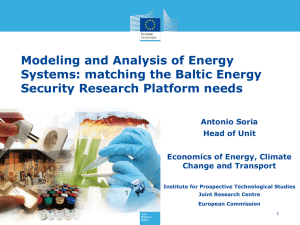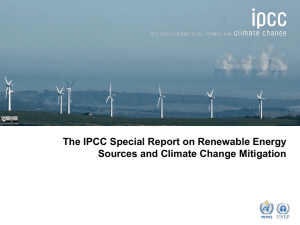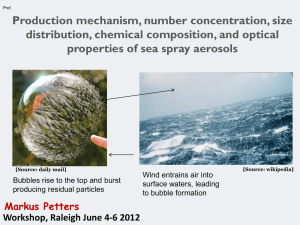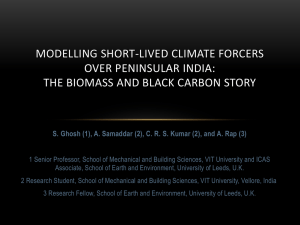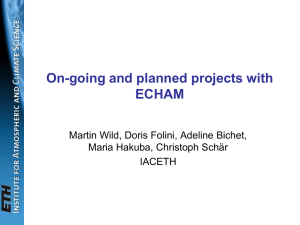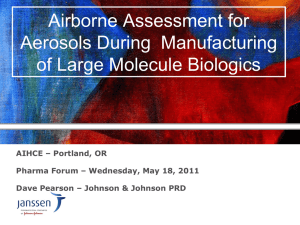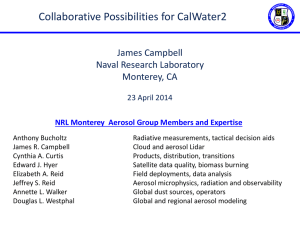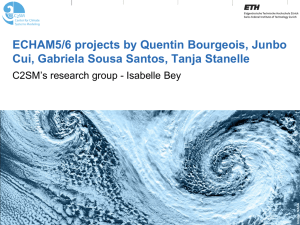Detection and attribution of climate change for the
advertisement
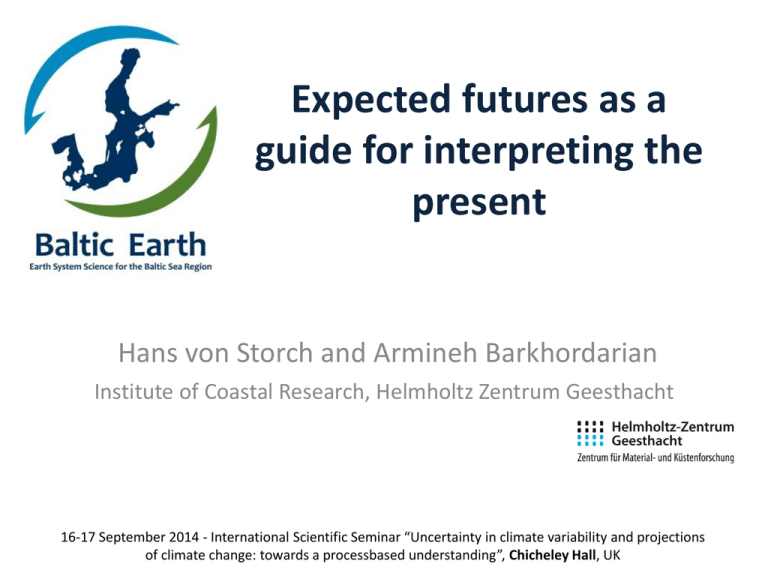
Expected futures as a guide for interpreting the present Hans von Storch and Armineh Barkhordarian Institute of Coastal Research, Helmholtz Zentrum Geesthacht 16-17 September 2014 - International Scientific Seminar “Uncertainty in climate variability and projections of climate change: towards a processbased understanding”, Chicheley Hall, UK Detection Detection is the successful process of demonstrating that an event (in particular a trend) is not within the range of natural (or otherwise controlled) variability. Successful detection means: there is a cause at work, which needs to be determined. Detection takes the form of a statistical hypothesis testing. The challenge is the determination of the range of natural variability; often control simulations of GCMs are used. When trying to enhance the signal-to-noise ratio (Hasselmann, 1979), the pattern of the expected event is used to project on the event – good knowledge about the future helps to succeed in detecting . The detection concept can also be used to demonstrate that a possible cause is – within the uncertainty of hypothesis testing – not alone at work. Example: Hiatus Motivation: The Hiatus problem • • • A 15-year trend of 0.0041 oC/year, which was determined for 1998-2012 using HadCRUT4, shows up in less than 1% of the time in CMIP3 and CMIP5 scenarios. Thus, when considering the GCM responses to elevated GHG levels as realistic, the recent trend can not be explained by these GHG increases alone. That means: - the effect of GHG is overestimated in the scenarios , or - other factors are at work as well Or, the inconsistency is related to a too constraint dynamical response of the climate systems in contemporary models (enhanced flow of heat into the ocean). Then, such models are compromised for the use as unbiased estimators for “natural variability” in detection studies. Consistency between the recent trend of the global mean annual temperature and simulations with climate models: the figure shows the proportion of simulated trends that are smaller or equal to the observed global annual trend in the period 19982012 in the HadCRUT4 data set, Rhadcrut15.= 0.0041 oC/year. The ensemble of simulated trends has been calculated from nonoverlapping periods of length n in the period 2001-2060. The climate models were driven by the emission scenarios RCP4.5 (CMIP5) and A1B (CMIP3). The inset shows an expanded view of the range 0% to 2% von Storch, H. A. Barkhordarian, K. Hasselmann and E. Zorita, 2013: Can climate models explain the recent stagnation in global warming?. rejected by nature; available from academia.edu It is my perception that we collectively have hardly been interested in cases, when detection of something has been achieved, but attribution of a consistent explanation fails. This perception may be false. Regional detection of caused changes in temperature trends (1984-2013) in the Baltic Sea Region, and determination of consistent causes A project of Baltic Earth Temperature trends (19832012) in the Baltic Sea Region Detection of external driver The observed (grey) trends in summer, and annually, are inconsistent with the hypothesis of internal/natural variations. Detection of non-GHG-driver The warming in JJA, SON and annually can hardly be explained with the driver acting in the scenario simulations (mostly GHGs). Observed area averaged changes of near surface temperature over the period 1984-2013 (grey bars) in comparison with GHG signal estimated from 9 CORDEX simulations based on RCP4.5 (green bars), 9 ENSEMBLES projections based on SRES A1B (blue bars). The brown whiskers denote the spread of trends of the two observational datasets (CRUv3, EOBS9.0). The blue whiskers indicate the 95th %tile uncertainty range of observed trends, derived from 2,000-year paleosimulation. The red and black whiskers show the spread of trends of 9 RCP4.5 and 9 A1B climate change projections. Thus, external drivers are most probably at work. GHG may be among them, but alone fail to explain the trends. Thus, other external drivers must be at work as well. Which other drivers? Candidate: regionally emitted aerosols. Historical development of sulphur dioxide emissions in Europe (Unit: Tg SO2; Vestreng et al., 2007) BACC-II Report, forthcoming Other driver Candidate: regionally emitted aerosols. Detection of positive trend (1984-2005) of surface solar radiation annually as well as seasonally in MAM, JJA and SON. Inconsistent with the trends in RCM scenarios. Seasonal area mean changes of observed surface solar radiation (W/m2/Decade) according to the CDR satellite data over the period 1984-2005 over the Baltic Sea region in comparison with the anthropogenic signal derived from the multi-model mean of RCM; simulations. The black whiskers indicate the spread of the trends of 10 climate change projections. The red whiskers denote the 90% uncertainty range of observed trends derived from 2,000 year paleo-simulations. Unfortunately, no RCM/GCM simulations known to us, which have simulated the climatic effect of changing aerosol emissions. Therefore we build an ad-hoc regression model Determining a regression model • Predictand: Baltic Sea Region (BSR) air temperature • Predictors: - Northern Hemisphere temperature (considered representative for the change related to ever increasing concentrations of greenhouse gases). Data are available since 1900 until 2013 (HadCRU). - Annual regional emissions of aerosols in Northern Europe. (Only decadal estimates are available to us between 1911 and 2000) The two normalized predictors, the annually resolved Northern Hemisphere air temperature TNH* and the decadally resolved Baltic Sea region aerosol emission ABSR* . The regression model T(t) = 0.62 × TNH* - 0.50 ABSR* + 4.83 Since the standard deviation of the NH temperature is about 0.6K, an increase of NH temperature by 1K goes along with a little more than 1K in then Baltic Sea Region. Since the predictors are normalized and almost decorrelated, the relative importance is about the ratio of the regression coefficients a/b 5/4. We propose that we attribute the past changes to both factors, with the regional aerosols contributing throughout the 20th century about 80% compared to the NH factor. Estimating the relative climatic importance of aerosol emissions For determining the relative importance of the regional emissions of aerosols we use the regression model to estimate the possible regional temperature and precipitation developments under assumed emissions. Three such as assumed emission • “Control”: a continuation of emissions through 2001 to 2012 as in the year 2000. • “1920 scenario”: a continuation of emissions as in 1920 in the years afterwards. • “1980 scenario”: a continuations of emissions as in 1980 in the years afterwards. Comparing trends • Trends derived from observations very similar (CRU, EOBS) • Observed trends outside range of RCM scenario trends (detection) • Regression 1980 scenario within range of RCM scenarios • “Control” (with assumed aerosol emissions since 2000) yields larger trend than all other timer series. Time series 1984-2013 Trend (K/decade) CRU 0.44 EOBS 0.46 RCM scenarios [0.22; 0.39] Regression control 0.83 Regression 1980 scenario 0.38 Conclusions • Detection concept also useful for determining if a purported driver is not the cause for an event (trend) • In case of Baltic Sea Region temperature, GHGs are positively insufficient for explaining recent warming patterns • A plausible co-driver of temperature change is regional aerosol emissions. • Conditional upon skill of regression model, the relative importance of GHG/regional aerosol forcing is about 5/4. • The decrease of global temperature before 1970s and the simultaneous increase in aerosol emissions caused a cooling of 1 - 1.5K. • The strong global temperature increase and the simultaneous decrease of regional aerosols went along with a strong regional temperature increase of 1,5 - 2 K since 1980. • The inconsistency of RCM scenarios and recent change stems from the strong regional aerosol influence, which is not considered in the RCM scenarios. • All conclusions conditional upon further refinement of statistical analysis, in particular after introducing better and longer aerosol data. Work still in progress Using better and longer records of aerosol presence in regional atmosphere. Precipitation


